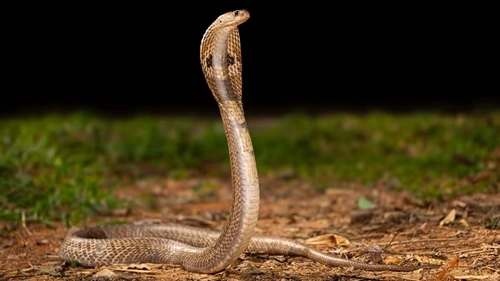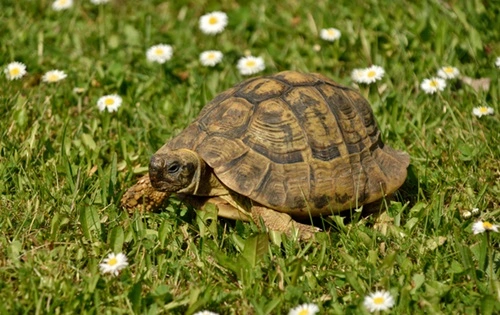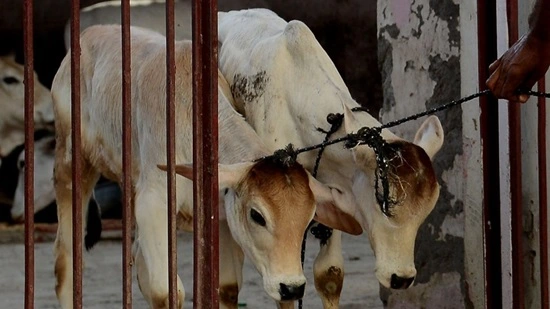India is home to a diverse range of snake species due to its rich biodiversity and varied ecological zones, from deserts and forests to wetlands and grasslands. Snakes play a crucial role in balancing ecosystems as natural predators, helping control pests like rodents and maintaining the food chain. India houses both venomous and non-venomous snakes, with some species being revered in cultural traditions while others remain subjects of curiosity and fear.
This article highlights more than 10 prominent snake species found in India, detailing their characteristics, habitats, and ecological importance.

1. Indian Cobra
The Indian Cobra is one of the “Big Four” venomous snakes of India and is highly recognizable by its hood, which bears a spectacle-like mark.
- Venom: Neurotoxic
- Length: 1.5–2.2 meters
- Habitat: Grasslands, forests, agricultural fields, and urban outskirts
- Regions: Across India
- Characteristics:
- Known for its dramatic hood expansion
- Plays a prominent role in Indian mythology and snake-charming traditions
- Feeds on rodents, frogs, and birds
- Importance: Controls pest populations and features in anti-venom production.
2. King Cobra
The King Cobra, the largest venomous snake in the world, is a majestic and iconic species found in India. It is known for its imposing size and potent venom.
- Venom: Neurotoxic
- Length: Up to 5.5 meters
- Habitat: Dense forests, mangroves, and hilly regions
- Regions: Western Ghats, Northeast India, Odisha, Andaman Islands
- Characteristics:
- Feeds primarily on other snakes (ophiophagy)
- Can stand up and look a human in the eye
- Builds nests for its eggs—unique among snakes
- Importance: Essential for maintaining ecological balance as a top predator.
3. Russell’s Viper
Russell’s Viper is one of the most dangerous venomous snakes in India, responsible for a significant number of snakebite incidents.
- Venom: Hemotoxic
- Length: 1–1.6 meters
- Habitat: Grasslands, farmlands, and scrub forests
- Regions: Throughout India except for high-altitude regions
- Characteristics:
- Has a stout body with prominent brown blotches
- Known for its loud hissing sound when threatened
- Feeds on rodents, making it common in agricultural areas
- Importance: Helps control pest populations in farmlands.
4. Indian Krait
The Indian Krait, another member of the Big Four, is a nocturnal snake known for its potent neurotoxic venom and glossy black body with white bands.
- Venom: Neurotoxic
- Length: 1–1.5 meters
- Habitat: Agricultural fields, open plains, and urban areas
- Regions: Across India
- Characteristics:
- Active primarily at night
- Feeds on rodents, frogs, and other snakes
- Known for its docile nature during the day
- Importance: Plays a role in reducing rodent populations in rural areas.
5. Saw-Scaled Viper
The Saw-Scaled Viper is a small but highly aggressive snake, known for its rapid strike and unique “sizzling” sound produced by rubbing its scales.
- Venom: Hemotoxic
- Length: 0.3–0.9 meters
- Habitat: Dry regions, deserts, and scrublands
- Regions: Rajasthan, Gujarat, and parts of Central and South India
- Characteristics:
- Highly irritable and quick to strike
- Camouflaged well in sandy and rocky habitats
- Importance: Despite its venomous nature, it helps control pests in arid regions.
6. Rat Snake
The Rat Snake is a large, non-venomous snake widely found across India. It is often mistaken for cobras due to its size and defensive behavior.
- Venom: Non-venomous
- Length: 2–3 meters
- Habitat: Agricultural fields, forests, and urban outskirts
- Regions: Across India
- Characteristics:
- Yellowish-brown or olive body
- Feeds on rodents, birds, and frogs
- Moves quickly and is an excellent climber
- Importance: Vital for controlling rodent populations.
7. Indian Rock Python
The Indian Rock Python is a non-venomous, constrictor snake known for its massive size and strength.
- Venom: Non-venomous
- Length: Up to 5 meters
- Habitat: Forests, wetlands, and rocky areas
- Regions: Throughout India, particularly in the Western Ghats and Northeast
- Characteristics:
- Has a thick, patterned body
- Feeds on small mammals, birds, and reptiles
- Non-aggressive unless provoked
- Importance: Contributes to maintaining prey populations in ecosystems.
8. Banded Sea Krait
The Banded Sea Krait is a venomous sea snake with distinctive black and white bands. It is found in coastal waters and mangrove regions of India.
- Venom: Neurotoxic
- Length: 1–1.5 meters
- Habitat: Coastal areas, coral reefs, and estuaries
- Regions: Andaman and Nicobar Islands, coastal Karnataka, and Tamil Nadu
- Characteristics:
- Highly venomous but rarely aggressive
- Excellent swimmer with a paddle-like tail
- Importance: Indicates healthy marine ecosystems.
9. Checkered Keelback
The Checkered Keelback is a common, non-venomous water snake found near water bodies.
- Venom: Non-venomous
- Length: 1–1.5 meters
- Habitat: Rivers, lakes, ponds, and wetlands
- Regions: Across India
- Characteristics:
- Has a checkered body pattern
- Feeds on fish and amphibians
- Importance: Maintains aquatic ecosystems by controlling fish populations.
10. Common Sand Boa
The Common Sand Boa is a non-venomous, burrowing snake found in arid and semi-arid regions of India.
- Venom: Non-venomous
- Length: 0.5–1 meter
- Habitat: Sandy soils, deserts, and scrublands
- Regions: Rajasthan, Gujarat, Maharashtra
- Characteristics:
- Thick cylindrical body with blunt tail
- Feeds on rodents and small reptiles
- Importance: Helps control rodent populations in arid zones.
Conclusion
India’s rich biodiversity supports a wide variety of snake species, each contributing significantly to maintaining ecological balance. From the highly venomous Indian Cobra and Russell’s Viper to the harmless Rat Snake and Indian Rock Python, snakes are vital to India’s wildlife and agricultural systems. By understanding these species, we can better appreciate their role and importance in nature.
FAQs
Q1: Which are the most venomous snakes in India?
A: The “Big Four” venomous snakes include the Indian Cobra, Russell’s Viper, Saw-Scaled Viper, and Indian Krait.
Q2: Which is the largest snake in India?
A: The King Cobra is the largest venomous snake, while the Indian Rock Python is the largest non-venomous snake.
Q3: Are all snakes venomous?
A: No, many snakes like Rat Snake, Indian Rock Python, and Common Sand Boa are non-venomous and harmless to humans.
Q4: Which snake species are found in water in India?
A: Species like the Banded Sea Krait and Checkered Keelback are commonly found in water bodies and coastal regions.
Q5: What role do snakes play in the ecosystem?
A: Snakes are essential for controlling pests (like rodents) and maintaining ecological balance as predators and prey.

